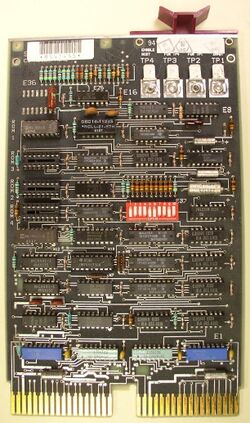M9312 ROM
The M9312 ROM card was a UNIBUS ROM card for the PDP-11 series of computers. It contained 512 words of ROM, all readable directly from the UNIBUS (i.e. not windowed). The M9312 also provided termination for the UNIBUS.
It was a dual format card, intended for use in the two top (AB) sections of a MUD slot, or in a UNIBUS in/out slot.
The board occupied addresses 773000-773776 (high ROM) and 765000-765776 (low ROM); a configuration jumper allowed the lower block to be disabled.
Contents
ROMs
The contents of the standard PROMs from DEC provided a virtual front panel emulator over the console asynchronous serial line, basic CPU and main memory diagnostics, and the ability to bootstrap the machine from disk, magnetic tape, etc; a command to boot the machine could be given in the emulator, using a symbolic device code. However, the board could be used for any purpose.
The board used five 4-bit wide PROMs to hold the data; the DEC-supplied pre-programmed PROMs included the console emulator and diagnostics in one ROM, and used the other four to hold the selected bootstraps (selected from a large set available from DEC, see below).
The diagnostics include i) primary CPU tests, ii) secondary CPU tests, and a memory test. The primary tests are performed before entering the console emulator; if a failure is detected, the processor goes into an infinite loop at the failing test. The secondary tests and memory test are run when a boot command is given from the console emulator.
There were two different emulator/diagnostic PROMs; one for the PDP-11/70 and PDP-11/60, which check the machine's cache, and one for all the other PDP-11 models.
Configuration
The board was configured using both a single 10-switch DIP switch, S1, and a number of jumpers, together with they control the board's behaviour.
Switches
Configuration switches control which address the CPU jumps to on power on.
A clever trick, controlled by one configuration switch, allowed the board to force the CPU to read its power-on PC and PS from the ROM, at a location set by other configuration switches, thereby allowing auto-boot on power-on.
If S1-2 is 'off', the system will power-up normally; if 'on', the CPU will obtain its new PC/PS pair from locations 173024 on the card, which contain a mixture of bits from the ROM (high bits) and the configuration switches (low bits), which can be used to force the CPU to start executing in the ROM on power-on. (This is done by asserting the appropriate high address lines on the UNIBUS for the first two bus cycles after power-up; a technique pioneered by the BM873 ROM.)
If S1-1 is set to 'off' (open), the new PS and PC loaded on power-on will point to the high ROM; if 'on' (closed), it will be in the low ROM. Switches S1-3 through S1-10 contain bits 8 through 1 of the power-on PC (above).
Jumpers
- W1-W5 - When inserted, termination is provided for the bus grant lines of the UNIBUS.
- W6 - In for machines with push-button boot capability
- W7 - Always in
- W8 - When inserted, the low bank of memory on the card (765000-765777) is disabled; when removed, it is enabled.
- W9-W10 - Out for use with a PDP-11/60; in for all others
- W11-W12 - In for use with a PDP-11/60; out for all others
Connector tabs
The board contains four connector tabs, which may be used with a pair of external switches, to control the board's behaviour.
Two, TP2 and TP3, are ground returns (for TP1 and TP4, respectively). TP1, when momemtarily grounded, forces the machine to execute a power-fail/restart sequence (by asserting UNIBUS line ACLO). TP4, when grounded, forces the machine to execute the on-board ROM on power on, no matter what the position of S1-2 (above).
PROM variants
The following table lists the DEC standard PROMs by part number, and the devices they support. When a particular PROM suppports more than one type of device, the second device type is indicated with a '*' after the part number.
| ROM part # | Device | Controller |
|---|---|---|
| 23-751A9 | RL01/RL02 disk | RL11 |
| 23-752A9 | RK06/RK07 disk | RK611 |
| 23-753A9 | RX01 floppy | RX11 |
| 23-811A9 | RX02 floppy | RX211 |
| 23-755A9 | RP02/RP03 disk | RP11 |
| 23-755A9* | RP04/RP05/RP06, RM02/03 disk | RH11, RH70 |
| 23-756A9 | RK02-RK03/RK05 disk | RK11 |
| 23-756A9* | TU55/TU56 DECtape | TC11 |
| 23-757A9 | TU16/TE16 magtape | TM02, TM03 |
| 23-758A9 | TU10/TE10/TS03 magtape | TM11 |
| 23-759A9 | RS03/04 fixed-head disk | RH11, RH70 |
| 23-760A9 | PC05 high-speed paper tape reader | PC11 |
| 23-760A9* | console low-speed reader | DL11 |
| 23-761A9 | TU60 DECcassette | TA11 |
| 23-762A9 | RS11 fixed-head disk | RF11 |
| 23-762A9* | RS64 fixed-head disk | RC11 |
| 23-763A9 | CR11 Card Reader punched card reader | CR11 |
| 23-764A9 | TS04, TU80 magtape | TS11, TU80K |
| 23-765A9 | TU58 DECtape II | DL11 |
See also
External links
- M9312 bootstrap/terminator module technical manual (EK-M9312-TM-002)
- M9312 Field Maintenance Print Set (MP00617)
- M9312 PROM Files
